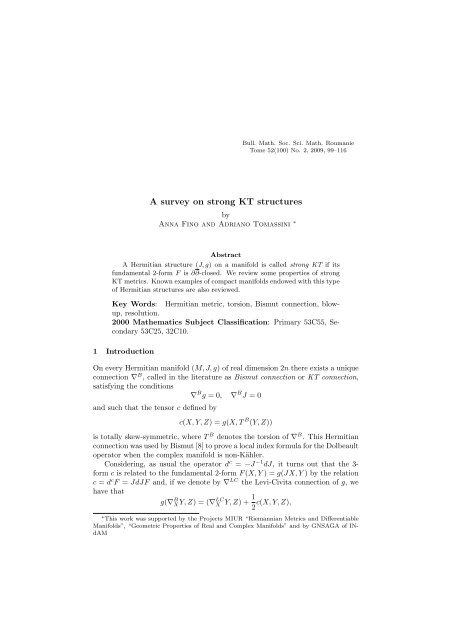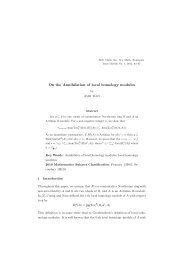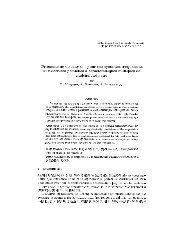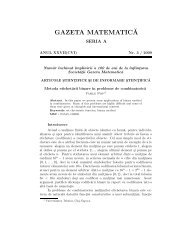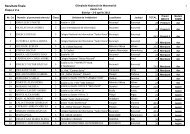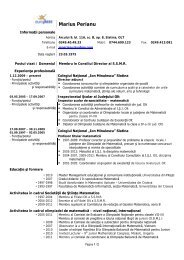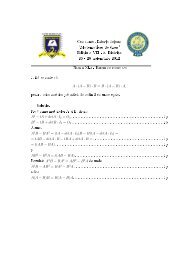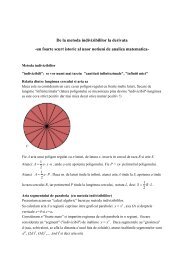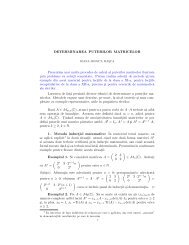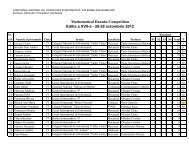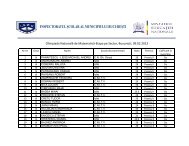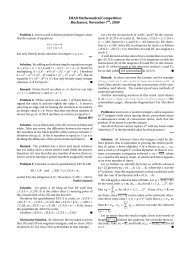A survey on strong KT structures - SSMR
A survey on strong KT structures - SSMR
A survey on strong KT structures - SSMR
Create successful ePaper yourself
Turn your PDF publications into a flip-book with our unique Google optimized e-Paper software.
Bull. Math. Soc. Sci. Math. RoumanieTome 52(100) No. 2, 2009, 99–116A <str<<strong>strong</strong>>on</<strong>strong</strong>>g>survey</str<<strong>strong</strong>>on</<strong>strong</strong>>g> <<strong>strong</strong>>on</<strong>strong</strong>> str<<strong>strong</strong>>on</<strong>strong</strong>>g <strong>KT</strong> <strong>structures</strong>byAnna Fino and Adriano Tomassini ∗AbstractA Hermitian structure (J, g) <<strong>strong</strong>>on</<strong>strong</strong>> a manifold is called str<<strong>strong</strong>>on</<strong>strong</strong>>g <strong>KT</strong> if itsfundamental 2-form F is ∂∂-closed. We review some properties of str<<strong>strong</strong>>on</<strong>strong</strong>>g<strong>KT</strong> metrics. Known examples of compact manifolds endowed with this typeof Hermitian <strong>structures</strong> are also reviewed.Key Words: Hermitian metric, torsi<<strong>strong</strong>>on</<strong>strong</strong>>, Bismut c<<strong>strong</strong>>on</<strong>strong</strong>>necti<<strong>strong</strong>>on</<strong>strong</strong>>, blowup,resoluti<<strong>strong</strong>>on</<strong>strong</strong>>.2000 Mathematics Subject Classificati<<strong>strong</strong>>on</<strong>strong</strong>>: Primary 53C55, Sec<<strong>strong</strong>>on</<strong>strong</strong>>dary53C25, 32C10.1 Introducti<<strong>strong</strong>>on</<strong>strong</strong>>On every Hermitian manifold (M,J,g) of real dimensi<<strong>strong</strong>>on</<strong>strong</strong>> 2n there exists a uniquec<<strong>strong</strong>>on</<strong>strong</strong>>necti<<strong>strong</strong>>on</<strong>strong</strong>> ∇ B , called in the literature as Bismut c<<strong>strong</strong>>on</<strong>strong</strong>>necti<<strong>strong</strong>>on</<strong>strong</strong>> or <strong>KT</strong> c<<strong>strong</strong>>on</<strong>strong</strong>>necti<<strong>strong</strong>>on</<strong>strong</strong>>,satisfying the c<<strong>strong</strong>>on</<strong>strong</strong>>diti<<strong>strong</strong>>on</<strong>strong</strong>>s∇ B g = 0, ∇ B J = 0and such that the tensor c defined byc(X,Y,Z) = g(X,T B (Y,Z))is totally skew-symmetric, where T B denotes the torsi<<strong>strong</strong>>on</<strong>strong</strong>> of ∇ B . This Hermitianc<<strong>strong</strong>>on</<strong>strong</strong>>necti<<strong>strong</strong>>on</<strong>strong</strong>> was used by Bismut [8] to prove a local index formula for the Dolbeaultoperator when the complex manifold is n<<strong>strong</strong>>on</<strong>strong</strong>>-Kähler.C<<strong>strong</strong>>on</<strong>strong</strong>>sidering, as usual the operator d c = −J −1 dJ, it turns out that the 3-form c is related to the fundamental 2-form F(X,Y ) = g(JX,Y ) by the relati<<strong>strong</strong>>on</<strong>strong</strong>>c = d c F = JdJF and, if we denote by ∇ LC the Levi-Civita c<<strong>strong</strong>>on</<strong>strong</strong>>necti<<strong>strong</strong>>on</<strong>strong</strong>> of g, wehave thatg(∇ B XY,Z) = (∇ LCX Y,Z) + 1 2 c(X,Y,Z),∗ This work was supported by the Projects MIUR “Riemannian Metrics and DifferentiableManifolds”, “Geometric Properties of Real and Complex Manifolds” and by GNSAGA of INdAM
100 Anna Fino and Adriano Tomassinifor any vector field X,Y,Z. Since ∇ B is a Hermitian c<<strong>strong</strong>>on</<strong>strong</strong>>necti<<strong>strong</strong>>on</<strong>strong</strong>>, its (restricted)hol<<strong>strong</strong>>on</<strong>strong</strong>>omy group Hol(∇ B ) is in general c<<strong>strong</strong>>on</<strong>strong</strong>>tained in the unitary group U(n).By [20] the c<<strong>strong</strong>>on</<strong>strong</strong>>necti<<strong>strong</strong>>on</<strong>strong</strong>> ∇ B bel<<strong>strong</strong>>on</<strong>strong</strong>>gs to a <<strong>strong</strong>>on</<strong>strong</strong>>e-parameter family of can<<strong>strong</strong>>on</<strong>strong</strong>>icalHermitian c<<strong>strong</strong>>on</<strong>strong</strong>>necti<<strong>strong</strong>>on</<strong>strong</strong>>s∇ t = t∇ C + (1 − t)∇ 0 ,where ∇ C and ∇ 0 denote the Chern c<<strong>strong</strong>>on</<strong>strong</strong>>necti<<strong>strong</strong>>on</<strong>strong</strong>> and the first can<<strong>strong</strong>>on</<strong>strong</strong>>ical c<<strong>strong</strong>>on</<strong>strong</strong>>necti<<strong>strong</strong>>on</<strong>strong</strong>>respectively. For t = −1 <<strong>strong</strong>>on</<strong>strong</strong>>e gets the Bismut c<<strong>strong</strong>>on</<strong>strong</strong>>necti<<strong>strong</strong>>on</<strong>strong</strong>> ∇ B .If c = 0, then the Bismut c<<strong>strong</strong>>on</<strong>strong</strong>>necti<<strong>strong</strong>>on</<strong>strong</strong>> ∇ B coincides with the Levi-Civita ∇ LCc<<strong>strong</strong>>on</<strong>strong</strong>>necti<<strong>strong</strong>>on</<strong>strong</strong>> and in this case the Hermitian manifold (M,J,g) is Kähler. In thisnote we are interested <<strong>strong</strong>>on</<strong>strong</strong>> n<<strong>strong</strong>>on</<strong>strong</strong>>-Kähler geometry and we study Hermitian <strong>structures</strong>whose fundamental 2-form F satisfies weaker c<<strong>strong</strong>>on</<strong>strong</strong>>diti<<strong>strong</strong>>on</<strong>strong</strong>>s than dF = 0. We recallthe following (see [22])Definiti<<strong>strong</strong>>on</<strong>strong</strong>> 1.1. Let M be a manifold of real dimensi<<strong>strong</strong>>on</<strong>strong</strong>> 2n. A Hermitian structure(J,g) <<strong>strong</strong>>on</<strong>strong</strong>> M or a J-Hermitian metric g is said to be str<<strong>strong</strong>>on</<strong>strong</strong>>g Kähler withtorsi<<strong>strong</strong>>on</<strong>strong</strong>> (str<<strong>strong</strong>>on</<strong>strong</strong>>g <strong>KT</strong>) if dc = 0, or, equivalently, if ∂∂F = 0 or dd c F = 0.The str<<strong>strong</strong>>on</<strong>strong</strong>>g <strong>KT</strong> metrics have been recently studied by many authors and theyhave also applicati<<strong>strong</strong>>on</<strong>strong</strong>>s in type II string theory and in 2-dimensi<<strong>strong</strong>>on</<strong>strong</strong>>al supersymmetricσ-models [22, 44, 34]. Moreover, they have also relati<<strong>strong</strong>>on</<strong>strong</strong>>s with generalizedKähler geometry (see for instance [22, 24, 31, 3, 12, 18]). Indeed, by [24, 3] itfollows that a generalized Kähler structure <<strong>strong</strong>>on</<strong>strong</strong>> a 2n-dimensi<<strong>strong</strong>>on</<strong>strong</strong>>al manifold M isequivalent to a pair of str<<strong>strong</strong>>on</<strong>strong</strong>>g <strong>KT</strong> <strong>structures</strong> (J + ,g) and (J − ,g), where J ± aretwo integrable almost complex <strong>structures</strong> <<strong>strong</strong>>on</<strong>strong</strong>> M and g is a Hermitian metric withrespect to J ± , such that the torsi<<strong>strong</strong>>on</<strong>strong</strong>> 3-form d c +F + = −d c −F − is closed, where F ±are the two fundamental 2-forms associated with the Hermitian <strong>structures</strong> (J ± ,g)and d c ± = i(∂ ± − ∂ ± ).By [43] any real compact semisimple Lie group G of even dimensi<<strong>strong</strong>>on</<strong>strong</strong>> has anatural str<<strong>strong</strong>>on</<strong>strong</strong>>g <strong>KT</strong> metric and a twisted generalized Kähler structure (see [24]).For the str<<strong>strong</strong>>on</<strong>strong</strong>>g <strong>KT</strong> structure, <<strong>strong</strong>>on</<strong>strong</strong>>e may choose as Hermitian structure (J,g), withJ a left-invariant complex structure and g a compatible bi-invariant metric. Theassociated Bismut c<<strong>strong</strong>>on</<strong>strong</strong>>necti<<strong>strong</strong>>on</<strong>strong</strong>> ∇ B is the flat c<<strong>strong</strong>>on</<strong>strong</strong>>necti<<strong>strong</strong>>on</<strong>strong</strong>> with skew-symmetrictorsi<<strong>strong</strong>>on</<strong>strong</strong>> g(X,[Y,Z]) corresp<<strong>strong</strong>>on</<strong>strong</strong>>ding to an invariant 3-form <<strong>strong</strong>>on</<strong>strong</strong>> the Lie algebra of G.As far as we know, the <<strong>strong</strong>>on</<strong>strong</strong>>ly known solvmanifolds, i.e. compact quotientsof solvable Lie groups by discrete subgroups, admitting a generalized Kählerstructure are the Inoue surface of type S M defined in [33] and the 6-dimensi<<strong>strong</strong>>on</<strong>strong</strong>>al<<strong>strong</strong>>on</<strong>strong</strong>>e found in [18]. This solvmanifold turns out to be a T 2 -bundle over the Inouesurface of type S M , whose c<<strong>strong</strong>>on</<strong>strong</strong>>structi<<strong>strong</strong>>on</<strong>strong</strong>> we will review in the last secti<<strong>strong</strong>>on</<strong>strong</strong>>.On a complex manifold of complex dimensi<<strong>strong</strong>>on</<strong>strong</strong>> n, if the (n − 1,n − 1)-formF n−1 =}F ∧ ...{{∧ F},(n−1)−timesis ∂∂-closed, then, according to [23], the Hermitian metric g is said to be standard.If we denote by δ the coderivative, then a Hermitian metric is standard if and
A <str<<strong>strong</strong>>on</<strong>strong</strong>>g>survey</str<<strong>strong</strong>>on</<strong>strong</strong>>g> <<strong>strong</strong>>on</<strong>strong</strong>> str<<strong>strong</strong>>on</<strong>strong</strong>>g <strong>KT</strong> <strong>structures</strong> 101<<strong>strong</strong>>on</<strong>strong</strong>>ly if the 1-form θ = JδF is co-closed. The 1-form θ is also called the Leeform and a Hermitian manifold is said to be balanced if θ = 0, or equivalently ifdF n−1 = 0 and c<<strong>strong</strong>>on</<strong>strong</strong>>formally balanced if θ is exact. C<<strong>strong</strong>>on</<strong>strong</strong>>sequently, <<strong>strong</strong>>on</<strong>strong</strong>> a complexsurface a standard Hermitian metric coincides with a str<<strong>strong</strong>>on</<strong>strong</strong>>g <strong>KT</strong> metric. If n > 2,then a direct computati<<strong>strong</strong>>on</<strong>strong</strong>> shows that a str<<strong>strong</strong>>on</<strong>strong</strong>>g <strong>KT</strong> g is standard if and <<strong>strong</strong>>on</<strong>strong</strong>>ly if|dF | 2 = (n − 1) 2 |θ ∧ F | 2 , where | · | denotes the norm <<strong>strong</strong>>on</<strong>strong</strong>> forms induced by g.By [23], it follows that any c<<strong>strong</strong>>on</<strong>strong</strong>>formal class of a Hermitian metric <<strong>strong</strong>>on</<strong>strong</strong>> a compactcomplex manifold can be represented by a standard metric. Thus, in particular,<<strong>strong</strong>>on</<strong>strong</strong>> a complex surface <<strong>strong</strong>>on</<strong>strong</strong>>e can be found a str<<strong>strong</strong>>on</<strong>strong</strong>>g <strong>KT</strong> metric in the c<<strong>strong</strong>>on</<strong>strong</strong>>formal classof any given Hermitian metric. So it is interesting to study str<<strong>strong</strong>>on</<strong>strong</strong>>g <strong>KT</strong> <strong>structures</strong>starting from real dimensi<<strong>strong</strong>>on</<strong>strong</strong>> at least six. Compact quotients of solvable (inparticular nilpotent) Lie groups by uniform discrete subgroups provide a naturalclass of examples to be investigated. Indeed, in general, it is well known thata nilmanifold, i.e. a compact quotient of a nilpotent Lie group by a discretesubgroup, cannot admit any Kähler structure unless it is a torus (see for instance[7]). Moreover, in the case of solvmanifolds, Hasegawa proved in [27, 28] thata solvmanifold carries a Kähler metric if and <<strong>strong</strong>>on</<strong>strong</strong>>ly if it is covered by a finitequotient of a complex torus, which has the structure of a complex torus bundleover a complex torus.This <str<<strong>strong</strong>>on</<strong>strong</strong>>g>survey</str<<strong>strong</strong>>on</<strong>strong</strong>>g> c<<strong>strong</strong>>on</<strong>strong</strong>>sists essentially of two parts. The first part collects somedefiniti<<strong>strong</strong>>on</<strong>strong</strong>>s and results <<strong>strong</strong>>on</<strong>strong</strong>> the hol<<strong>strong</strong>>on</<strong>strong</strong>>omy of the Bismut c<<strong>strong</strong>>on</<strong>strong</strong>>necti<<strong>strong</strong>>on</<strong>strong</strong>>, str<<strong>strong</strong>>on</<strong>strong</strong>>g <strong>KT</strong><strong>structures</strong>, in relati<<strong>strong</strong>>on</<strong>strong</strong>> also with the blow-up of a complex manifold and withresoluti<<strong>strong</strong>>on</<strong>strong</strong>>s of orbifolds. The sec<<strong>strong</strong>>on</<strong>strong</strong>>d part reviews the c<<strong>strong</strong>>on</<strong>strong</strong>>structi<<strong>strong</strong>>on</<strong>strong</strong>> of the examplesfound in [16, 17, 18, 19].Acknowledgements We would like to thank Liviu Ornea for the invitati<<strong>strong</strong>>on</<strong>strong</strong>> to writethis paper.2 Hol<<strong>strong</strong>>on</<strong>strong</strong>>omy of the Bismut c<<strong>strong</strong>>on</<strong>strong</strong>>necti<<strong>strong</strong>>on</<strong>strong</strong>> in SU(n)A 2n-dimensi<<strong>strong</strong>>on</<strong>strong</strong>>al Hermitian manifold (M,J,g) is said to be Calabi-Yau withtorsi<<strong>strong</strong>>on</<strong>strong</strong>>, shortly CY T, if the restricted hol<<strong>strong</strong>>on</<strong>strong</strong>>omy group of the Bismut c<<strong>strong</strong>>on</<strong>strong</strong>>necti<<strong>strong</strong>>on</<strong>strong</strong>>Hol(∇ B ) is c<<strong>strong</strong>>on</<strong>strong</strong>>tained in SU(n). In such a case, we have that the first Chern classc 1 (M) of (M,J) is zero.In [25] it was c<<strong>strong</strong>>on</<strong>strong</strong>>jectured that any compact complex manifold (M,J) withc 1 (M) = 0 admits a Hermitian metric such that Hol(∇ B ) ⊆ SU(n). A counterexampleto the above c<<strong>strong</strong>>on</<strong>strong</strong>>jecture has been found, showing that the c<<strong>strong</strong>>on</<strong>strong</strong>>diti<<strong>strong</strong>>on</<strong>strong</strong>>Hol(∇ B ) ⊆ SU(n) is also not stable under small deformati<<strong>strong</strong>>on</<strong>strong</strong>>s of the complexstructure in [16]. The example was c<<strong>strong</strong>>on</<strong>strong</strong>>structed by using the followingTheorem 2.1. [16] Let (M,J) be a compact complex manifold of complex dimensi<<strong>strong</strong>>on</<strong>strong</strong>>n with a holomorphic n<<strong>strong</strong>>on</<strong>strong</strong>>-vanishing (n,0)-form. If the Ricci tensor ofthe Bismut c<<strong>strong</strong>>on</<strong>strong</strong>>necti<<strong>strong</strong>>on</<strong>strong</strong>> of some Hermitian metric g vanishes, then (M,J,g) isc<<strong>strong</strong>>on</<strong>strong</strong>>formally balanced and in particular admits a balanced metric.The previous theorem can be applied for instance to any nilmanifold Γ\G,
102 Anna Fino and Adriano Tomassiniendowed with a left-invariant complex structure. In general, by [39] any simplyc<<strong>strong</strong>>on</<strong>strong</strong>>nected Lie group which admits a discrete subgroup with compact quotient isunimodular and in particular has a bi-invariant volume form dµ. For the balancedc<<strong>strong</strong>>on</<strong>strong</strong>>diti<<strong>strong</strong>>on</<strong>strong</strong>>, by using a “symmetrizati<<strong>strong</strong>>on</<strong>strong</strong>>” process, which is based <<strong>strong</strong>>on</<strong>strong</strong>> a previous ideaof Belgun [6], <<strong>strong</strong>>on</<strong>strong</strong>>e has the followingTheorem 2.2. [16] Let M be the compact quotient Γ\G of a 2n-dimensi<<strong>strong</strong>>on</<strong>strong</strong>>al Liegroup G by a discrete subgroup Γ. If M admits a left-invariant complex structureJ and F is the fundamental 2-form of a n<<strong>strong</strong>>on</<strong>strong</strong>>-invariant J-Hermitian metric g,then∫α(A 1 ,...,A 2n−2 ) = F n−1 | m (A 1 | m ,...A 2n−2 | m )dµ,Mis equal to ˜F n−1 for some fundamental 2-form ˜F of a left-invariant J-invariantHermitian metric ˜g. If dF n−1 = 0, then d ˜F n−1 = 0.Therefore, if g is balanced, then (M,J) admits a left-invariant balanced J-Hermitian metric ˜g. By using essentially the same argument, Ugarte showedin [46] that if the Hermitian metric g is str<<strong>strong</strong>>on</<strong>strong</strong>>g <strong>KT</strong>, then (M,J) admits a leftinvariantinvariant J-Hermitian metric ˜g, which is str<<strong>strong</strong>>on</<strong>strong</strong>>g <strong>KT</strong>.By using Theorem 2.1 and 2.2 the first author with Grantcharov c<<strong>strong</strong>>on</<strong>strong</strong>>structedin [16] a family of left-invariant complex <strong>structures</strong> <<strong>strong</strong>>on</<strong>strong</strong>> the Iwasawa manifold notadmitting balanced metrics, except for the natural bi-invariant complex structure.Example 2.3. The Iwasawa manifold is the compact quotient Γ\HC 3, where⎧⎛⎞ ⎫⎨ 1 z 1 z 3 ⎬H3 C = ⎝ 0 1 z 2 ⎠ : z j ∈ C⎩⎭ ,0 0 1is the complex Heisenberg group and Γ is the uniform discrete subgroup of HC3defined by z j , j = 1,2,3, Gaussian integers. Let g s,t be the family of 2-stepnilpotent Lie algebras defined by:⎧⎪⎨de j = 0, j = 1,...,4,de 5 = s(e 1 ∧ e 2 + 2e 3 ∧ e 4 ) + t(e 1 ∧ e 3 − e 2 ∧ e 4 ),⎪⎩de 6 = t(e 1 ∧ e 4 + e 2 ∧ e 3 ),where t ≠ 0 and s are real numbers. For any t ≠ 0 and s, the Lie algebra g t,sis isomorphic to the Lie algebra of H 3 C . Therefore, by c<<strong>strong</strong>>on</<strong>strong</strong>>sidering <<strong>strong</strong>>on</<strong>strong</strong>> g t,s thecomplex structure defined by the (1,0)-formsη 1 = e 1 + ie 2 , η 2 = e 3 + ie 4 , η 3 = e 5 + ie 6 ,<<strong>strong</strong>>on</<strong>strong</strong>>e gets a family of left-invariant complex <strong>structures</strong> J t,s <<strong>strong</strong>>on</<strong>strong</strong>> the Iwasawa manifold.In [16] it was proved that the Iwasawa manifold (Γ\H 3 C ,J t,s) admits ametric with vanishing Ricci tensor for the Bismut c<<strong>strong</strong>>on</<strong>strong</strong>>necti<<strong>strong</strong>>on</<strong>strong</strong>> if and <<strong>strong</strong>>on</<strong>strong</strong>>ly if s = 0.
A <str<<strong>strong</strong>>on</<strong>strong</strong>>g>survey</str<<strong>strong</strong>>on</<strong>strong</strong>>g> <<strong>strong</strong>>on</<strong>strong</strong>> str<<strong>strong</strong>>on</<strong>strong</strong>>g <strong>KT</strong> <strong>structures</strong> 103Moreover, this example shows also that the property “vanishing Ricci tensorfor the Bismut c<<strong>strong</strong>>on</<strong>strong</strong>>necti<<strong>strong</strong>>on</<strong>strong</strong>>” is not stable under small deformati<<strong>strong</strong>>on</<strong>strong</strong>>s of the complexstructure.The balanced c<<strong>strong</strong>>on</<strong>strong</strong>>diti<<strong>strong</strong>>on</<strong>strong</strong>> is complementary to the str<<strong>strong</strong>>on</<strong>strong</strong>>g <strong>KT</strong> <<strong>strong</strong>>on</<strong>strong</strong>>e. Indeed, by[4], a (n<<strong>strong</strong>>on</<strong>strong</strong>>-Kähler) Hermitian metric g <<strong>strong</strong>>on</<strong>strong</strong>> a complex manifold (M,J) of complexdimensi<<strong>strong</strong>>on</<strong>strong</strong>> n > 2, can be str<<strong>strong</strong>>on</<strong>strong</strong>>g <strong>KT</strong>, <<strong>strong</strong>>on</<strong>strong</strong>>ly if the Lee form θ does not vanish.In [34], it was shown that a c<<strong>strong</strong>>on</<strong>strong</strong>>formally balanced str<<strong>strong</strong>>on</<strong>strong</strong>>g <strong>KT</strong> structure (J,g) <<strong>strong</strong>>on</<strong>strong</strong>>a compact manifold M of real dimensi<<strong>strong</strong>>on</<strong>strong</strong>> 2n with Hol(∇ B ) ⊆ SU(n) is necessarilyKähler and therefore it gives rise to a Calabi-Yau structure.It is an interesting problem to find examples of complex manifolds whichadmit str<<strong>strong</strong>>on</<strong>strong</strong>>g CYT <strong>structures</strong>. Sufficient c<<strong>strong</strong>>on</<strong>strong</strong>>diti<<strong>strong</strong>>on</<strong>strong</strong>>s for principal toric bundlesover compact Kähler manifolds to admit Calabi-Yau with torsi<<strong>strong</strong>>on</<strong>strong</strong>> <strong>structures</strong> andas well str<<strong>strong</strong>>on</<strong>strong</strong>>g <strong>KT</strong> metrics have been found in [21].We will provide a compact example of str<<strong>strong</strong>>on</<strong>strong</strong>>g CYT manifold, c<<strong>strong</strong>>on</<strong>strong</strong>>structed asa T 2 -bundle over the Hopf surface. This complex manifold is locally c<<strong>strong</strong>>on</<strong>strong</strong>>formallybalanced, i.e. its Lee form θ is closed and n<<strong>strong</strong>>on</<strong>strong</strong>>-exact.Example 2.4. We recall that a Hopf surface is diffeomorphic to a fiber bundleX = S 1 × Zm S 3 /K over S 1 with fiber S 3 /K, where K is a finite subgroup ofU(2) acting freely <<strong>strong</strong>>on</<strong>strong</strong>> X [29]. Then, the Hopf surface can be also viewed as acompact quotient X = L/Θ, where the Lie algebra of L is l = su(2) ⊕ IR and Θis a uniform discrete subgroup of L.C<<strong>strong</strong>>on</<strong>strong</strong>>sider the 6-dimensi<<strong>strong</strong>>on</<strong>strong</strong>>al Lie algebra g with structure equati<<strong>strong</strong>>on</<strong>strong</strong>>s:⎧de 1 = e 2 ∧ e 3 ,de 2 = e 3 ∧ e 1 ,⎪⎨ de 3 = e 1 ∧ e 2 ,(1)de 4 = 0,de⎪⎩5 = e 6 ∧ e 4 ,de 6 = e 4 ∧ e 5 .The Lie algebra g is the direct sum su(2) ⊕ h, where h is a 3-dimensi<<strong>strong</strong>>on</<strong>strong</strong>>aln<<strong>strong</strong>>on</<strong>strong</strong>>-completely solvable Lie algebra. Moreover, l = span < e 1 ,e 2 ,e 3 ,e 4 > is a Liesubalgebra of g, where we denote by {e 1 ,...,e 6 } the dual basis of {e 1 ,...,e 6 }.Define the almost complex <strong>structures</strong> J <<strong>strong</strong>>on</<strong>strong</strong>> g, by settingη 1 = e 1 + ie 4 , η 2 = e 2 + ie 3 , η 3 = e 5 + ie 6 .Then by definiti<<strong>strong</strong>>on</<strong>strong</strong>> (η 1 ,η 2 ,η 3 ) are the (1,0)-forms associated with J. The almostcomplex structure J is integrable. Indeed:dη 1 = i 2 η2 ∧ η 2 ,dη 2 = i 2 (η1 ∧ η 2 + η 1 ∧ η 2 ),dη 3 = 1 2 (η1 ∧ η 3 − η 1 ∧ η 3 ).
104 Anna Fino and Adriano TomassiniC<<strong>strong</strong>>on</<strong>strong</strong>>sider the inner product g defined byg =6∑e j ⊗ e j . (2)j=1Thus g is J-Hermitian. Denote by F the fundamental 2-form associated with theHermitian structure (J,g). By a direct computati<<strong>strong</strong>>on</<strong>strong</strong>> we haveJdF = −e 1 ∧ e 2 ∧ e 3 ,with e 1 ∧ e 2 ∧ e 3 a closed and n<<strong>strong</strong>>on</<strong>strong</strong>>-exact 3-form.Therefore g admits a str<<strong>strong</strong>>on</<strong>strong</strong>>g <strong>KT</strong> structure defined by (J,g). The Bismut c<<strong>strong</strong>>on</<strong>strong</strong>>necti<<strong>strong</strong>>on</<strong>strong</strong>>∇ B in this case is flat. Indeed, the torsi<<strong>strong</strong>>on</<strong>strong</strong>> of ∇ B is the 3-formJdF = −e 1 ∧ e 2 ∧ e 3 .Hence, the torsi<<strong>strong</strong>>on</<strong>strong</strong>> forms τ i ,i = 1,...,6 of ∇ B are given byτ 1 = e 2 ∧ e 3 , τ 2 = −e 2 ∧ e 3 , τ 3 = e 1 ∧ e 2 , τ 4 = 0, τ 5 = 0, τ 6 = 0.Denoting by ω i j the c<<strong>strong</strong>>on</<strong>strong</strong>>necti<<strong>strong</strong>>on</<strong>strong</strong>>s 1-forms of ∇B , by the Cartan structure equati<<strong>strong</strong>>on</<strong>strong</strong>>s6∑de i + ωj i ∧ e j = τ i , ωj i + ω j ij=1= 0, i,j = 1,...,6, (3)we immediately getω 5 6 = e 4 ,the other ω i j being zero. Hence ∇B is flat and c<<strong>strong</strong>>on</<strong>strong</strong>>sequently its hol<<strong>strong</strong>>on</<strong>strong</strong>>omy algebrais trivial. Moreover, the Lee form, given by e 4 is closed and then the Hermitianmetric is locally c<<strong>strong</strong>>on</<strong>strong</strong>>formally balanced. The simply c<<strong>strong</strong>>on</<strong>strong</strong>>nected Lie group H withLie algebra h is a semi-direct product of the form IR⋉IR 2 and by c<<strong>strong</strong>>on</<strong>strong</strong>>sidering thelattice Γ in H generated by 1 2 and Z2 , <<strong>strong</strong>>on</<strong>strong</strong>>e has that b 1 (Γ\H) = 1. Therefore, theabove Hermitian structure (J,g) <<strong>strong</strong>>on</<strong>strong</strong>> g induces a left-invariant Hermitian structure(J,g) <<strong>strong</strong>>on</<strong>strong</strong>> the compact manifold M = Γ\H ×S 3 /K, which can be viewed as a n<<strong>strong</strong>>on</<strong>strong</strong>>trivialT 2 -bundle over the Hopf surface. Note that∂ ( η 1 ∧ η 2 ∧ η 3) = 1 2 (1 − i) η1 ∧ η 1 ∧ η 2 ∧ η 3 ,and thus there are no left-invariant holomorphic (3,0)-forms <<strong>strong</strong>>on</<strong>strong</strong>> M. Since thehol<<strong>strong</strong>>on</<strong>strong</strong>>omy of the Bismut c<<strong>strong</strong>>on</<strong>strong</strong>>necti<<strong>strong</strong>>on</<strong>strong</strong>> is c<<strong>strong</strong>>on</<strong>strong</strong>>tained in SU(3), then by [16, Theorem4.1] (M,J) cannot admit any n<<strong>strong</strong>>on</<strong>strong</strong>>-vanishing holomorphic (3,0)-form. Indeed, if(M,J) admits such a form, then (J,g) has to be c<<strong>strong</strong>>on</<strong>strong</strong>>formally balanced, but thisis not possible since (J,g) is str<<strong>strong</strong>>on</<strong>strong</strong>>g <strong>KT</strong>.
A <str<<strong>strong</strong>>on</<strong>strong</strong>>g>survey</str<<strong>strong</strong>>on</<strong>strong</strong>>g> <<strong>strong</strong>>on</<strong>strong</strong>> str<<strong>strong</strong>>on</<strong>strong</strong>>g <strong>KT</strong> <strong>structures</strong> 1053 Str<<strong>strong</strong>>on</<strong>strong</strong>>g <strong>KT</strong> metrics, currents, blow-ups and resoluti<<strong>strong</strong>>on</<strong>strong</strong>>sOn a compact complex manifold the Kähler, balanced and str<<strong>strong</strong>>on</<strong>strong</strong>>g <strong>KT</strong> c<<strong>strong</strong>>on</<strong>strong</strong>>diti<<strong>strong</strong>>on</<strong>strong</strong>>can be characterized by using c<<strong>strong</strong>>on</<strong>strong</strong>>diti<<strong>strong</strong>>on</<strong>strong</strong>>s <<strong>strong</strong>>on</<strong>strong</strong>> the space of positive currents.We start to review some known facts about positive currents. Let Ω be an openset of C n and let Λ p,q (Ω) (respectively by D p,q (Ω)) be the space of (p,q)-forms(respectively (p,q)-forms with compact support) <<strong>strong</strong>>on</<strong>strong</strong>> Ω. On the space D p,q (Ω) <<strong>strong</strong>>on</<strong>strong</strong>>ec<<strong>strong</strong>>on</<strong>strong</strong>>siders the C ∞ -topology and <<strong>strong</strong>>on</<strong>strong</strong>>e defines the space of currents of bi-dimensi<<strong>strong</strong>>on</<strong>strong</strong>>(p,q) or of bi-degree (n − p,n − q) as the topological dual D p,q(Ω) ′ of D p,q (Ω). Acurrent of bi-dimensi<<strong>strong</strong>>on</<strong>strong</strong>> (p,q) <<strong>strong</strong>>on</<strong>strong</strong>> Ω can be viewed as a (n − p,n − q)-form <<strong>strong</strong>>on</<strong>strong</strong>> Ωwith coefficients distributi<<strong>strong</strong>>on</<strong>strong</strong>>s.A current T ∈ D p,q(Ω) ′ is said to be of order 0 if its coefficients are measuresand is called normal if T and dT are currents of order 0.A current T of bi-dimensi<<strong>strong</strong>>on</<strong>strong</strong>> (p,p) is real if T(ϕ) = T(ϕ), for any ϕ ∈ D p,q (Ω).Therefore, if T ∈ D p,p(Ω) ′ is real, then T can be expressed as∑T = σ n−p T IJdz I ∧ dz J ,I,Jwhere σ n−p = i(n−p)22 (n−p) , T IJare distributi<<strong>strong</strong>>on</<strong>strong</strong>>s <<strong>strong</strong>>on</<strong>strong</strong>> Ω such that T JI= T IJand I, Jare multi-indices of length n − p, I = (i 1 ,...,i n−p ), dz I = dz i1 ∧ · · · ∧ dz in−p .A real current T ∈ D ′ p,p(Ω) is positive ifT(σ p ϕ 1 ∧ · · · ∧ ϕ p ∧ ϕ 1 ∧ · · · ∧ ϕ p ) ≥ 0for any choice of ϕ 1 ,...,ϕ p ∈ D 1,0 (Ω), where σ p = ip22 p . Moreover, T is strictlypositive if ϕ 1 ∧ · · · ∧ ϕ p ≠ 0 implies T(σ p ϕ 1 ∧ · · · ∧ ϕ p ∧ ϕ 1 ∧ · · · ∧ ϕ p ) > 0.If T is a positive current of bi-degree (p,p), then T is of order 0.A real current T of bi-dimensi<<strong>strong</strong>>on</<strong>strong</strong>> (p,p) <<strong>strong</strong>>on</<strong>strong</strong>> Ω is said to be negative if the current−T is positive and plurisubharm<<strong>strong</strong>>on</<strong>strong</strong>>ic if i∂∂T is positive.Given a Hermitian structure (J,g) <<strong>strong</strong>>on</<strong>strong</strong>> a complex manifold M, then the fundamental2-form F corresp<<strong>strong</strong>>on</<strong>strong</strong>>ds to a real strictly positive current of bi-degree(1,1). In particular, if the Hermitian structure (J,g) is str<<strong>strong</strong>>on</<strong>strong</strong>>g <strong>KT</strong>, then thecorresp<<strong>strong</strong>>on</<strong>strong</strong>>ding current is ∂∂-closed.An important type of ∂∂-closed currents is given by the (p,p)-comp<<strong>strong</strong>>on</<strong>strong</strong>>ents ofa boundary. We recall that a current T of bi-degree (p,p) is said to be the (p,p)-comp<<strong>strong</strong>>on</<strong>strong</strong>>ent of a boundary if there exists a real current S of bi-degree (p,p − 1)such that T = ∂S + ∂S.Harvey and Laws<<strong>strong</strong>>on</<strong>strong</strong>> proved that a compact complex manifold admits a Kählermetric if and <<strong>strong</strong>>on</<strong>strong</strong>>ly if there is no n<<strong>strong</strong>>on</<strong>strong</strong>>-zero positive current of bi-dimensi<<strong>strong</strong>>on</<strong>strong</strong>> (1,1)which is the (1,1)-comp<<strong>strong</strong>>on</<strong>strong</strong>>ent of a boundary (see [26]). A first generalizati<<strong>strong</strong>>on</<strong>strong</strong>> ofthe previous result was obtained by Michels<<strong>strong</strong>>on</<strong>strong</strong>> in [40] and it is the following: acompact complex manifold has a balanced metric if and <<strong>strong</strong>>on</<strong>strong</strong>>ly if there is no n<<strong>strong</strong>>on</<strong>strong</strong>>zeropositive current of bi-dimensi<<strong>strong</strong>>on</<strong>strong</strong>> (n − 1,n − 1), which is the (n − 1,n − 1)-comp<<strong>strong</strong>>on</<strong>strong</strong>>ent of a boundary. In the case of str<<strong>strong</strong>>on</<strong>strong</strong>>g <strong>KT</strong> metrics, Egidi proved in [14]
106 Anna Fino and Adriano Tomassinithat a compact complex manifold has a str<<strong>strong</strong>>on</<strong>strong</strong>>g <strong>KT</strong> metric if and <<strong>strong</strong>>on</<strong>strong</strong>>ly if there isno n<<strong>strong</strong>>on</<strong>strong</strong>>-zero positive current of bi-dimensi<<strong>strong</strong>>on</<strong>strong</strong>> (1,1) which is dd c -exact.Miyaoka proved in [41] that, if a compact complex manifold has a Kählermetric in the complement of a point, then it admits itself a Kähler metric.By using a deep extensi<<strong>strong</strong>>on</<strong>strong</strong>> and regularity result for positive or negative plurisubharm<<strong>strong</strong>>on</<strong>strong</strong>>iccurrents by Alessandrini and Bassanelli (see [2]) we get the followingTheorem 3.1. [19] If M 2n \ {p}, n ≥ 2, admits a str<<strong>strong</strong>>on</<strong>strong</strong>>g <strong>KT</strong> metric, then thereexists a str<<strong>strong</strong>>on</<strong>strong</strong>>g <strong>KT</strong> metric <<strong>strong</strong>>on</<strong>strong</strong>> M 2n .This theorem is a generalizati<<strong>strong</strong>>on</<strong>strong</strong>> of Miyaoka’s extensi<<strong>strong</strong>>on</<strong>strong</strong>> result (see [41]).A classical result by Blanchard (see [9]) states that the blow-up of a Kählermanifold at a point or al<<strong>strong</strong>>on</<strong>strong</strong>>g a compact complex submanifold is still Kähler. Forthe str<<strong>strong</strong>>on</<strong>strong</strong>>g <strong>KT</strong> case we have the same result (see [19]), namelyTheorem 3.2. The blow-up of a str<<strong>strong</strong>>on</<strong>strong</strong>>g <strong>KT</strong> manifold (M,J,g) at a point or al<<strong>strong</strong>>on</<strong>strong</strong>>ga compact complex submanifold of M is still str<<strong>strong</strong>>on</<strong>strong</strong>>g <strong>KT</strong>.Then, as an applicati<<strong>strong</strong>>on</<strong>strong</strong>> of the previous theorem we have that, if M is acomplex manifold and ˜M p is the blow-up of M at a point p ∈ M, then ˜M p has astr<<strong>strong</strong>>on</<strong>strong</strong>>g <strong>KT</strong> metric if and <<strong>strong</strong>>on</<strong>strong</strong>>ly if M admits a str<<strong>strong</strong>>on</<strong>strong</strong>>g <strong>KT</strong> metric.Theorem 3.1 can be applied to complex orbifolds endowed with a str<<strong>strong</strong>>on</<strong>strong</strong>>g <strong>KT</strong>metric in a similar way as for the symplectic orbifolds (see [11]).We start with recalling that a complex orbifold is a singular complex manifold Mof dimensi<<strong>strong</strong>>on</<strong>strong</strong>> n such that each singularity p is locally isomorphic to U/G, whereU is an open set of C n , G is a finite subgroup of GL(n, C) acting linearly <<strong>strong</strong>>on</<strong>strong</strong>> Uwith the <<strong>strong</strong>>on</<strong>strong</strong>>ly <<strong>strong</strong>>on</<strong>strong</strong>>e fixed point p. Moreover, the set S of singular points of M ofthe orbifold M has real codimensi<<strong>strong</strong>>on</<strong>strong</strong>> at least two.Therefore, for instance, the quotient of a complex manifold by a holomorphicacti<<strong>strong</strong>>on</<strong>strong</strong>> of a finite group G with n<<strong>strong</strong>>on</<strong>strong</strong>>-identity fixed point sets of real codimensi<<strong>strong</strong>>on</<strong>strong</strong>>at least two <<strong>strong</strong>>on</<strong>strong</strong>>e is a complex orbifold.The noti<<strong>strong</strong>>on</<strong>strong</strong>>s of smooth r-forms and (p,q)-forms make also sense <<strong>strong</strong>>on</<strong>strong</strong>> complexorbifolds and the differential d splits as usual as d = ∂ + ∂. A Hermitian metricg <<strong>strong</strong>>on</<strong>strong</strong>> a complex orbifold (M,J) is a J-Hermitian metric in the usual sense <<strong>strong</strong>>on</<strong>strong</strong>>the n<<strong>strong</strong>>on</<strong>strong</strong>>-singular part of (M,J) and G-invariant in any chart U/G. In this case,for any chart U/G, we have G ⊂ U(n). The Hermitian metric <<strong>strong</strong>>on</<strong>strong</strong>> the complexorbifold (M,J) is str<<strong>strong</strong>>on</<strong>strong</strong>>g <strong>KT</strong> if ∂∂F = 0, where F is the fundamental 2-formassociated to (J,g).We recall that in general a resoluti<<strong>strong</strong>>on</<strong>strong</strong>> ( ˜M,π) of a singular complex variety Mis a normal, n<<strong>strong</strong>>on</<strong>strong</strong>>singular complex variety ˜M with a proper surjective birati<<strong>strong</strong>>on</<strong>strong</strong>>almorphism π : ˜M → M. In [19] we studied the resoluti<<strong>strong</strong>>on</<strong>strong</strong>> of singularities of acomplex orbifold endowed with a str<<strong>strong</strong>>on</<strong>strong</strong>>g <strong>KT</strong> metric in order to obtain a smoothcomplex manifold admitting a str<<strong>strong</strong>>on</<strong>strong</strong>>g <strong>KT</strong> metric. We set the followingDefiniti<<strong>strong</strong>>on</<strong>strong</strong>> 3.3. Let (M,J,g) be a complex orbifold endowed with a str<<strong>strong</strong>>on</<strong>strong</strong>>g <strong>KT</strong>metric g . A str<<strong>strong</strong>>on</<strong>strong</strong>>g <strong>KT</strong> resoluti<<strong>strong</strong>>on</<strong>strong</strong>> of a str<<strong>strong</strong>>on</<strong>strong</strong>>g <strong>KT</strong> orbifold (M,J,g) is the datum
A <str<<strong>strong</strong>>on</<strong>strong</strong>>g>survey</str<<strong>strong</strong>>on</<strong>strong</strong>>g> <<strong>strong</strong>>on</<strong>strong</strong>> str<<strong>strong</strong>>on</<strong>strong</strong>>g <strong>KT</strong> <strong>structures</strong> 107of a smooth complex manifold ( ˜M, ˜J) endowed with a ˜J-Hermitian str<<strong>strong</strong>>on</<strong>strong</strong>>g <strong>KT</strong>metric ˜g and of a map π : ˜M → M, such thati) π : ˜M \ E → M \ S is a biholomorphism, where S is the singular set of Mand E = π −1 (S) is the excepti<<strong>strong</strong>>on</<strong>strong</strong>>al set;ii) ˜g = π ∗ g <<strong>strong</strong>>on</<strong>strong</strong>> the complement of a neighborhood of E.By applying Hir<<strong>strong</strong>>on</<strong>strong</strong>>aka Resoluti<<strong>strong</strong>>on</<strong>strong</strong>> of Singularities Theorem [32] to resolve thesingularities of a complex algebraic variety by a finite number of blow-ups, in [19]we proved the followingTheorem 3.4. Let (M,J) be a complex orbifold of complex dimensi<<strong>strong</strong>>on</<strong>strong</strong>> n endowedwith a J-Hermitian str<<strong>strong</strong>>on</<strong>strong</strong>>g <strong>KT</strong> metric g. Then there exists a str<<strong>strong</strong>>on</<strong>strong</strong>>g <strong>KT</strong> resoluti<<strong>strong</strong>>on</<strong>strong</strong>>.4 Simply-c<<strong>strong</strong>>on</<strong>strong</strong>>nected examplesIn [19] we applied the previous theorem to a quotient of a torus by the finite groupZ 2 . More precisely let T 6 = R 6 /Z 6 be the standard torus and let (x 1 ,...,x 6 ) beglobal coordinates <<strong>strong</strong>>on</<strong>strong</strong>> R 2n .C<<strong>strong</strong>>on</<strong>strong</strong>>sider <<strong>strong</strong>>on</<strong>strong</strong>> T 6 the involuti<<strong>strong</strong>>on</<strong>strong</strong>> σ induced byσ ( (x 1 ,...,x 6 ) ) = (−x 1 ,...,−x 6 ).and the complex structure J defined by{η 1 = dx 1 + i ( f dx 3 + dx 4) ,η j = dx j + idx 3+j , j = 2,3,where f = f(x 3 ,x 6 ) is a C ∞ , Z 6 -periodic and even functi<<strong>strong</strong>>on</<strong>strong</strong>>.Then, as a c<<strong>strong</strong>>on</<strong>strong</strong>>sequence of Theorem 3.4, we can prove the followingTheorem 4.1. [19] The quotient (T 6 /〈σ〉,J) is a complex orbifold with singularpoint setS ={x + Z 6 | x ∈ 1 }2 Z6 .The J-Hermitian metric g = 1 2∑ nj=1(η j ⊗ η j + η j ⊗ η j) is str<<strong>strong</strong>>on</<strong>strong</strong>>g <strong>KT</strong>. Moreover,(T 6 /〈σ〉,J) admits a str<<strong>strong</strong>>on</<strong>strong</strong>>g <strong>KT</strong> resoluti<<strong>strong</strong>>on</<strong>strong</strong>> which is simply-c<<strong>strong</strong>>on</<strong>strong</strong>>nected.Very interesting examples of 6-dimensi<<strong>strong</strong>>on</<strong>strong</strong>>al simply-c<<strong>strong</strong>>on</<strong>strong</strong>>nected str<<strong>strong</strong>>on</<strong>strong</strong>>g <strong>KT</strong> manifoldswere found in [21] by using torus bundles. They proved that for everypositive integer k ≥ 1, the manifold (k −1)(S 2 ×S 4 )♯k(S 3 ×S 3 ) admits a str<<strong>strong</strong>>on</<strong>strong</strong>>g
108 Anna Fino and Adriano Tomassini<strong>KT</strong> structure, or alternatively, that any 6-dimensi<<strong>strong</strong>>on</<strong>strong</strong>>al compact simply-c<<strong>strong</strong>>on</<strong>strong</strong>>nectedspin manifold with torsi<<strong>strong</strong>>on</<strong>strong</strong>> free cohomology and free S 1 -acti<<strong>strong</strong>>on</<strong>strong</strong>> has a str<<strong>strong</strong>>on</<strong>strong</strong>>g <strong>KT</strong>metric. The previous manifold has been c<<strong>strong</strong>>on</<strong>strong</strong>>structed as a real two-dimensi<<strong>strong</strong>>on</<strong>strong</strong>>altoric bundle over the complex surface obtained as blow up of the complex projectiveplane CP 2 at k (k ≥ 2) points <<strong>strong</strong>>on</<strong>strong</strong>> a smooth irreducible cubic.Recently Swann in [45] reproduced the previous examples via the twist c<<strong>strong</strong>>on</<strong>strong</strong>>structi<<strong>strong</strong>>on</<strong>strong</strong>>,extending them to higher dimensi<<strong>strong</strong>>on</<strong>strong</strong>>s, and finding further compactsimply-c<<strong>strong</strong>>on</<strong>strong</strong>>nected str<<strong>strong</strong>>on</<strong>strong</strong>>g <strong>KT</strong> manifolds. The basic idea of this c<<strong>strong</strong>>on</<strong>strong</strong>>structi<<strong>strong</strong>>on</<strong>strong</strong>> is toc<<strong>strong</strong>>on</<strong>strong</strong>>sider a manifold M with an acti<<strong>strong</strong>>on</<strong>strong</strong>> of a n-dimensi<<strong>strong</strong>>on</<strong>strong</strong>>al torus T n . If P → M is isa principal T n -bundle with c<<strong>strong</strong>>on</<strong>strong</strong>>necti<<strong>strong</strong>>on</<strong>strong</strong>> and if the T n -acti<<strong>strong</strong>>on</<strong>strong</strong>> lifts to P commutingwith the principal acti<<strong>strong</strong>>on</<strong>strong</strong>>, then <<strong>strong</strong>>on</<strong>strong</strong>>e can c<<strong>strong</strong>>on</<strong>strong</strong>>struct the quotient space (the “twist ”)P/T n . Moreover, if the lifted T n -acti<<strong>strong</strong>>on</<strong>strong</strong>> preserves the principal c<<strong>strong</strong>>on</<strong>strong</strong>>necti<<strong>strong</strong>>on</<strong>strong</strong>>, thentensors <<strong>strong</strong>>on</<strong>strong</strong>> M can be transferred to tensors <<strong>strong</strong>>on</<strong>strong</strong>> the quotient P/T n by requiringtheir pull-backs to P to coincide <<strong>strong</strong>>on</<strong>strong</strong>> horiz<<strong>strong</strong>>on</<strong>strong</strong>>tal vectors. In this way, an invariantgeometric structure <<strong>strong</strong>>on</<strong>strong</strong>> M determines a corresp<<strong>strong</strong>>on</<strong>strong</strong>>ding geometric structure <<strong>strong</strong>>on</<strong>strong</strong>> thetwist P/T n .5 6-dimensi<<strong>strong</strong>>on</<strong>strong</strong>>al str<<strong>strong</strong>>on</<strong>strong</strong>>g <strong>KT</strong> nilmanifoldsOther examples, besides the compact semisimple Lie groups, of homogeneousstr<<strong>strong</strong>>on</<strong>strong</strong>>g <strong>KT</strong> manifolds have been found in [17] and they are 6-dimensi<<strong>strong</strong>>on</<strong>strong</strong>>al nilmanifoldsΓ\G, i.e. compact quotients of 6-dimensi<<strong>strong</strong>>on</<strong>strong</strong>>al nilpotent Lie groups G bydiscrete subgroups Γ.By the classificati<<strong>strong</strong>>on</<strong>strong</strong>> obtained in [17] it turns out that <<strong>strong</strong>>on</<strong>strong</strong>>ly 4 classes of 6-dimensi<<strong>strong</strong>>on</<strong>strong</strong>>al nilpotent Lie algebras admit a str<<strong>strong</strong>>on</<strong>strong</strong>>g <strong>KT</strong> structure and that theexistence of a str<<strong>strong</strong>>on</<strong>strong</strong>>g <strong>KT</strong> metric compatible with a left-invariant complex structureJ <<strong>strong</strong>>on</<strong>strong</strong>> the nilmanifold Γ\G depends <<strong>strong</strong>>on</<strong>strong</strong>>ly <<strong>strong</strong>>on</<strong>strong</strong>> the complex structure J.More preciselyTheorem 5.1. [17] Let M = Γ\G be a 6-dimensi<<strong>strong</strong>>on</<strong>strong</strong>>al nilmanifold, J be a leftinvariantcomplex structure and g any J-Hermitian metric. Then the Hermitianstructure (J,g) is str<<strong>strong</strong>>on</<strong>strong</strong>>g <strong>KT</strong> if and <<strong>strong</strong>>on</<strong>strong</strong>>ly if there exists a basis (α 1 ,α 2 ,α 3 ) ofleft-invariant (1,0)-forms such that⎧⎪⎨⎪⎩with A,B,C,D,E ∈ C such thatdα 1 = dα 2 = 0,dα 3 = Aα 1 ∧ α 2 + Bα 2 ∧ α 2 + Cα 1 ∧ α 1 +Dα 1 ∧ α 2 + Eα 1 ∧ α 2|A| 2 + |D| 2 + |E| 2 + 2Re (BC) = 0.
A <str<<strong>strong</strong>>on</<strong>strong</strong>>g>survey</str<<strong>strong</strong>>on</<strong>strong</strong>>g> <<strong>strong</strong>>on</<strong>strong</strong>> str<<strong>strong</strong>>on</<strong>strong</strong>>g <strong>KT</strong> <strong>structures</strong> 109As a c<<strong>strong</strong>>on</<strong>strong</strong>>sequence of the last Theorem, the nilpotent Lie group G has to be2-step and the existence of a str<<strong>strong</strong>>on</<strong>strong</strong>>g <strong>KT</strong> metric depends <<strong>strong</strong>>on</<strong>strong</strong>>ly <<strong>strong</strong>>on</<strong>strong</strong>> the complexstructure. By applying Nomizu’s result [37] about the de Rham cohomology of anilmanifold, <<strong>strong</strong>>on</<strong>strong</strong>>e obtains that the first Betti number b 1 (M) of M is at least 4.The previous result has been used in [17] to classify explicitly the real 6-dimensi<<strong>strong</strong>>on</<strong>strong</strong>>al nilpotent Lie algebras admitting a str<<strong>strong</strong>>on</<strong>strong</strong>>g <strong>KT</strong> structure. Indeed, <<strong>strong</strong>>on</<strong>strong</strong>>ehas that a 6-dimensi<<strong>strong</strong>>on</<strong>strong</strong>>al nilmanifold M = Γ\G, endowed with a left-invariantcomplex structure J, has a J-Hermitian str<<strong>strong</strong>>on</<strong>strong</strong>>g <strong>KT</strong> metric if and <<strong>strong</strong>>on</<strong>strong</strong>>ly if the Liealgebra g of G is isomorphic to <<strong>strong</strong>>on</<strong>strong</strong>>e of the following(0,0,0,0,13 + 42,14 + 23),,(0,0,0,0,12,14 + 23),(0,0,0,0,12,34),(0,0,0,0,0,12),where, for instance for (0,0,0,0,0,12) we mean the Lie algebra with structureequati<<strong>strong</strong>>on</<strong>strong</strong>>s{de i = 0, i = 1,...,5,de 6 = e 1 ∧ e 2 .A detailed study of the str<<strong>strong</strong>>on</<strong>strong</strong>>g <strong>KT</strong> <strong>structures</strong>, up to equivalence of the complexstructure <<strong>strong</strong>>on</<strong>strong</strong>> 6-dimensi<<strong>strong</strong>>on</<strong>strong</strong>>al nilpotent Lie algebra, was also carried out in [46].By [45] the str<<strong>strong</strong>>on</<strong>strong</strong>>g <strong>KT</strong> nilmanifolds can be also obtained applying repeatedlythe “twist c<<strong>strong</strong>>on</<strong>strong</strong>>structi<<strong>strong</strong>>on</<strong>strong</strong>> ”to a torus.Since the c<<strong>strong</strong>>on</<strong>strong</strong>>diti<<strong>strong</strong>>on</<strong>strong</strong>> str<<strong>strong</strong>>on</<strong>strong</strong>>g <strong>KT</strong> <<strong>strong</strong>>on</<strong>strong</strong>> the 6-dimensi<<strong>strong</strong>>on</<strong>strong</strong>>al nilmanifolds depends <<strong>strong</strong>>on</<strong>strong</strong>>ly<<strong>strong</strong>>on</<strong>strong</strong>> the complex structure, in [17] we studied the str<<strong>strong</strong>>on</<strong>strong</strong>>g <strong>KT</strong> equati<<strong>strong</strong>>on</<strong>strong</strong>>s when G isthe complex Heisenberg group HC 3 and the compact quotient M = Γ\H3 C is theIwasawa manifold. N<<strong>strong</strong>>on</<strong>strong</strong>>e of the standard complex <strong>structures</strong> (see [1]) <<strong>strong</strong>>on</<strong>strong</strong>> HC 3 arestr<<strong>strong</strong>>on</<strong>strong</strong>>g <strong>KT</strong>, so it was interesting to discover which <<strong>strong</strong>>on</<strong>strong</strong>>es are.By the results of [38], the features of an invariant complex structure J <<strong>strong</strong>>on</<strong>strong</strong>> Mdepend <<strong>strong</strong>>on</<strong>strong</strong>> a matrix XX, where X is a 2 × 2 matrix representing the inducedacti<<strong>strong</strong>>on</<strong>strong</strong>> of J <<strong>strong</strong>>on</<strong>strong</strong>> M/T 2 ∼ = T 4 , by viewing the Iwasawa manifold M as the totalspace of a T 2 -bundle over T 4 . In [17] it is showed that the str<<strong>strong</strong>>on</<strong>strong</strong>>g <strong>KT</strong> c<<strong>strong</strong>>on</<strong>strong</strong>>diti<<strong>strong</strong>>on</<strong>strong</strong>>c<<strong>strong</strong>>on</<strong>strong</strong>>strains the eigenvalues of XX to be complex c<<strong>strong</strong>>on</<strong>strong</strong>>jugates lying <<strong>strong</strong>>on</<strong>strong</strong>> the curve ofequati<<strong>strong</strong>>on</<strong>strong</strong>>(1 + |z| 2 ) |1+z| 2 = 8|z| 2in the complex plane.Moreover, by [19] the Iwasawa manifold Γ\H C 3 is also an example for whichthe c<<strong>strong</strong>>on</<strong>strong</strong>>diti<<strong>strong</strong>>on</<strong>strong</strong>> for a Hermitian metric to be str<<strong>strong</strong>>on</<strong>strong</strong>>g <strong>KT</strong> is not stable under smalldeformati<<strong>strong</strong>>on</<strong>strong</strong>>s of the complex structure underlying the str<<strong>strong</strong>>on</<strong>strong</strong>>g <strong>KT</strong> structure.
110 Anna Fino and Adriano Tomassini6 A 6-dimensi<<strong>strong</strong>>on</<strong>strong</strong>>al generalized Kähler structure solvmanifoldGeneralized Kähler <strong>structures</strong> have been introduced by Gualtieri in [24] in thec<<strong>strong</strong>>on</<strong>strong</strong>>text of generalized geometries as generalizati<<strong>strong</strong>>on</<strong>strong</strong>> of Kähler <strong>structures</strong>:Definiti<<strong>strong</strong>>on</<strong>strong</strong>> 6.1. A generalized Kähler structure <<strong>strong</strong>>on</<strong>strong</strong>> a 2n-dimensi<<strong>strong</strong>>on</<strong>strong</strong>>al manifoldM is a pair (J 1 , J 2 ) of generalized complex <strong>structures</strong> <<strong>strong</strong>>on</<strong>strong</strong>> M such that1. J 1 and J 2 commute;2. J 1 and J 2 are compatible with the indefinite metric (, ) <<strong>strong</strong>>on</<strong>strong</strong>> TM ⊕ T ∗ M;3. the bilinear form −(J 1 J 2 ·, ·) is positive definite.In terms of bi-Hermitian geometry, Apostolov and Gualtieri proved in [3] thata generalized Kähler structure <<strong>strong</strong>>on</<strong>strong</strong>> M is equivalent to a triple (g,J + ,J − ) where:1. g is a Riemannian metric <<strong>strong</strong>>on</<strong>strong</strong>> M;2. J + and J − are two complex <strong>structures</strong> <<strong>strong</strong>>on</<strong>strong</strong>> M compatible with g such thatd c +F + + d c −F − = 0, dd c +F + = dd c −F − = 0,where d c ± = i(∂ ± − ∂ ± ) and F ± is the fundamental form of the Hermitianstructure (J ± ,g).The 3-form d c +F + is called the torsi<<strong>strong</strong>>on</<strong>strong</strong>> form of the generalized Kähler structureand the generalized Kähler structure is said to be untwisted if the de Rhamcohomology class [d c +F + ] ∈ H 3 (M) vanishes and twisted if [d c +F + ] ≠ 0.C<<strong>strong</strong>>on</<strong>strong</strong>>structi<<strong>strong</strong>>on</<strong>strong</strong>>s of n<<strong>strong</strong>>on</<strong>strong</strong>>-trivial generalized Kähler <strong>structures</strong> are given for instancein [24, 3, 5, 31, 36, 35, 15]. For example in [36] the generalized Kählerquotient c<<strong>strong</strong>>on</<strong>strong</strong>>structi<<strong>strong</strong>>on</<strong>strong</strong>> is c<<strong>strong</strong>>on</<strong>strong</strong>>sidered in relati<<strong>strong</strong>>on</<strong>strong</strong>> with the hyperkähler quotient c<<strong>strong</strong>>on</<strong>strong</strong>>structi<<strong>strong</strong>>on</<strong>strong</strong>>and generalized Kähler <strong>structures</strong> are given <<strong>strong</strong>>on</<strong>strong</strong>> CP n , <<strong>strong</strong>>on</<strong>strong</strong>> some toric varietiesand <<strong>strong</strong>>on</<strong>strong</strong>> the complex Grassmannian.An interesting problem is thus to look for compact examples of generalizedKähler manifolds which do not admit any Kähler structure. A natural class ofmanifolds where to investigate the existence of these <strong>structures</strong> is provided byLie groups.By [24] any real compact semisimple Lie group G of even dimensi<<strong>strong</strong>>on</<strong>strong</strong>> admitsa twisted generalized Kähler structure. Indeed, by [42] G has left and rightinvariant complex <strong>structures</strong> J L and J R , which can be choosen to be Hermitianwith respect to the bi-invariant metric induced by the Killing form. Both (J L ,g)and (J R ,g) are str<<strong>strong</strong>>on</<strong>strong</strong>>g <strong>KT</strong> <strong>structures</strong> and the Bismut c<<strong>strong</strong>>on</<strong>strong</strong>>necti<<strong>strong</strong>>on</<strong>strong</strong>> ∇ is the flatc<<strong>strong</strong>>on</<strong>strong</strong>>necti<<strong>strong</strong>>on</<strong>strong</strong>> with skew-symmetric torsi<<strong>strong</strong>>on</<strong>strong</strong>> g(X,[Y,Z]). Moreover, (J L ,J R ,g) is ageneralized Kähler structure.In [10] Cavalcanti proved that there are no nilmanifolds, except tori, carryingan invariant generalized Kähler structure, since every generalized complex
A <str<<strong>strong</strong>>on</<strong>strong</strong>>g>survey</str<<strong>strong</strong>>on</<strong>strong</strong>>g> <<strong>strong</strong>>on</<strong>strong</strong>> str<<strong>strong</strong>>on</<strong>strong</strong>>g <strong>KT</strong> <strong>structures</strong> 111structure <<strong>strong</strong>>on</<strong>strong</strong>> a nilpotent Lie algebra has holomorphically trivial can<<strong>strong</strong>>on</<strong>strong</strong>>ical bundle.About solvmanifolds no general results are known for the existence of generalizedKähler (n<<strong>strong</strong>>on</<strong>strong</strong>> Kähler) <strong>structures</strong>.In this secti<<strong>strong</strong>>on</<strong>strong</strong>> we review the c<<strong>strong</strong>>on</<strong>strong</strong>>structi<<strong>strong</strong>>on</<strong>strong</strong>> of the 6-dimensi<<strong>strong</strong>>on</<strong>strong</strong>>al generalizedKähler solvmanifold obtained in [18] as T 2 -bundle over an Inoue surface of typeS M .Let s a,b be the 2-step solvable Lie algebra with structure equati<<strong>strong</strong>>on</<strong>strong</strong>>s:⎧de 1 = ae 1 ∧ e 2 ,de 2 = 0,⎪⎨ de 3 = 1 2 ae2 ∧ e 3 ,⎪⎩de 4 = 1 2 ae2 ∧ e 4 ,de 5 = be 2 ∧ e 6 ,de 6 = −be 2 ∧ e 5 ,where a and b are n<<strong>strong</strong>>on</<strong>strong</strong>>-zero real numbers.If we denote by S a,b the simply-c<<strong>strong</strong>>on</<strong>strong</strong>>nected solvable Lie group with Lie algebras a,b , then the product <<strong>strong</strong>>on</<strong>strong</strong>> the Lie group, in terms of the global coordinates(t,x 1 ,x 2 ,x 3 ,x 4 ,x 5 ) <<strong>strong</strong>>on</<strong>strong</strong>> IR 6 , is given by:(t,x 1 ,x 2 ,x 3 ,x 4 ,x 5 ) · (t ′ ,x ′ 1,x ′ 2,x ′ 3,x ′ 4,x ′ 5) = (t + t ′ , e −a t x ′ 1 + x 1 , e a 2 t x ′ 2 + x 2 ,e a 2 t x ′ 3 + x 3 ,x ′ 4 cos(bt) − x ′ 5 sin(bt) + x 4 ,x ′ 4 sin(bt) + x ′ 5 cos(bt) + x 5 ).(4)Since the trace of ad X vanishes for any X ∈ s a,b and ad e2 has complex eigenvalues,the Lie group S a,b is unimodular and it is n<<strong>strong</strong>>on</<strong>strong</strong>>-completely solvable. Moreover,S a,b is as a semi-direct product of the formIR ⋉ ϕ (IR × IR 2 × IR 2 ),where ϕ = (ϕ 1 ,ϕ 2 ) is the diag<<strong>strong</strong>>on</<strong>strong</strong>>al acti<<strong>strong</strong>>on</<strong>strong</strong>> of IR <<strong>strong</strong>>on</<strong>strong</strong>> (IR×IR 2 )×IR 2 described by (4).In c<<strong>strong</strong>>on</<strong>strong</strong>>trast with the nilpotent case, there are no existence theorems for uniformdiscrete subgroups of a solvable Lie group and, if the Lie group is n<<strong>strong</strong>>on</<strong>strong</strong>>-completelysolvable and admits a compact quotient, <<strong>strong</strong>>on</<strong>strong</strong>>e cannot apply Hattori’s theorem [30]to compute the de Rham cohomology of the compact quotient.In [18] we showed that S a,b admits a compact quotient. Indeed <<strong>strong</strong>>on</<strong>strong</strong>>e has thefollowingTheorem 6.2 ([18]). Let S 1, π2Lie algebra s 1, π . Then 21. S 1, π has a compact quotient M6 = Γ\S2 1, π2Γ.be the simply-c<<strong>strong</strong>>on</<strong>strong</strong>>nected solvable Lie group withby a uniform discrete subgroup
112 Anna Fino and Adriano Tomassini2. The compact manifold M 6 is the total space of a T 2 -bundle over an Inouesurface S M .3. M 6 has first Betti number equal to 1, thus it has no Kähler <strong>structures</strong>.4. The solvmanifold M 6 carries a left-invariant (n<<strong>strong</strong>>on</<strong>strong</strong>>-trivial) twisted generalizedKähler structure.In order to obtain a uniform discrete subgroup Γ of S a,b , in [18] we showedthat the solvable Lie group S 1, π is isomorphic to (IR6 = IR ⋉ (IR × C × C), ∗)2with product ∗ given by(t,u,z,w) ∗ (t ′ ,u ′ ,z ′ ,w ′ ) = (t + t ′ ,c t u ′ + u,α t z ′ + z,e i π 2 t w ′ + w),for any t,t ′ ,u,u ′ ∈ IR and z,z ′ ,w,w ′ ∈ C.It turns out that the discrete subgroup Γ is isomorphic to Z ⋉( Z 3 × Z 2 ) andit is generated by the transformati<<strong>strong</strong>>on</<strong>strong</strong>>sMoreover, the mapg 0 : (t,u,z,w) ↦→ (t + 1,cu,αz,iw),g j : (t,u,z,w) ↦→ (t,u + c j ,z + α j ,w), j = 1,2,3,g 4 : (t,u,z,w) ↦→ (t,u,z,w + 1),g 5 : (t,u,z,w) ↦→ (t,u,z,w + i).π :IR ⋉ (IR × C × C) → IR ⋉ (IR × C),(t,u,z,w) ↦→ (t,u,z)inherits to M 6 the structure of a T 2 -bundle over an Inoue surface of type S M .In [18] we proved thatΓ/[Γ,Γ] ∼ = Zand c<<strong>strong</strong>>on</<strong>strong</strong>>sequently the first Betti number of M 6 is equal to 1.The left-invariant generalized Kähler structure is defined by the pair of Hermitian<strong>structures</strong> (J ± ,g) <<strong>strong</strong>>on</<strong>strong</strong>> the Lie algebra s 1, π , given by the two integrable2complex <strong>structures</strong> J ± associated with the (1,0)-formsω 1 + = e 1 + ie 2 , ω 2 + = e 3 + ie 4 , ω 3 + = e 5 + ie 6 ,ω 1 − = e 1 − ie 2 , ω 2 − = e 3 + ie 4 , ω 3 − = e 5 + ie 6 .and compatible with the inner productg =6∑e α ⊗ e α .α=1
A <str<<strong>strong</strong>>on</<strong>strong</strong>>g>survey</str<<strong>strong</strong>>on</<strong>strong</strong>>g> <<strong>strong</strong>>on</<strong>strong</strong>> str<<strong>strong</strong>>on</<strong>strong</strong>>g <strong>KT</strong> <strong>structures</strong> 113By a direct computati<<strong>strong</strong>>on</<strong>strong</strong>> we get thatd c +F + = −d c −F − = e 1 ∧ e 3 ∧ e 4 ,which is a closed 3-form. Therefore, since the 3-form is n<<strong>strong</strong>>on</<strong>strong</strong>>-exact, the corresp<<strong>strong</strong>>on</<strong>strong</strong>>dingleft-invariant generalized Kähler structure <<strong>strong</strong>>on</<strong>strong</strong>> M 6 is twisted.References[1] E. Abbena, S. Garbiero, and S. Salam<<strong>strong</strong>>on</<strong>strong</strong>>, Almost Hermitian geometryof 6-dimensi<<strong>strong</strong>>on</<strong>strong</strong>>al nilmanifolds, Ann. Sc. Norm. Sup. 30 (2001), 147–170.[2] L. Alessandrini and G. Bassanelli, Plurisubharm<<strong>strong</strong>>on</<strong>strong</strong>>ic currents andtheir exstensi<<strong>strong</strong>>on</<strong>strong</strong>> across analytic subsets, Forum Math. 5 (1993), 291–316.[3] V. Apostolov and M. Gualtieri, Generalized Kähler manifolds withsplit tangent bundle, Comm. Math. Phys. 271 (2007), 561–575.[4] B. Alexandrov and S. Ivanov, Vanishing theorems <<strong>strong</strong>>on</<strong>strong</strong>> Hermitian manifolds,Diff. Geom. Appl. 14 (2001), 251–265.[5] H. Bursztyn, G. Cavalcanti and M. Gualtieri, Reducti<<strong>strong</strong>>on</<strong>strong</strong>> of Courantalgebroids and generalized complex <strong>structures</strong>, Adv. Math. 211 (2007), 726–765.[6] F.A. Belgun, On the metric structure of n<<strong>strong</strong>>on</<strong>strong</strong>>-Kähler complex surfaces,Math. Ann. 317 (2000), 1–40.[7] C. Bens<<strong>strong</strong>>on</<strong>strong</strong>> and C. Gord<<strong>strong</strong>>on</<strong>strong</strong>>: Kähler and symplectic <strong>structures</strong> <<strong>strong</strong>>on</<strong>strong</strong>> nilmanifolds,Topology 27 (1988), 513–518.[8] J.M. Bismut, A local index theorem of n<<strong>strong</strong>>on</<strong>strong</strong>>-Kähler manifolds, Math. Ann.284 (1989), 681–699.[9] A. Blanchard, Sur les variétés analtyques complexe, Ann. Scient. del’E.N.S. 73 (1956), 157–202.[10] G.R. Cavalcanti, Formality in generalized Kähler geometry, TopologyAppl. 154 (2007), 119–1125.[11] G. R. Cavalcanti, M. Fernández and V. Munoz, Symplectic resoluti<<strong>strong</strong>>on</<strong>strong</strong>>s,Lefschetz property and formality, Adv. Math. 218 (2008), 576–599.[12] G. R. Cavalcanti and M. Gualtieri, Generalized complex <strong>structures</strong> <<strong>strong</strong>>on</<strong>strong</strong>>nilmanifolds, J. Symplectic Geom. 2 (2004), 393–410.
114 Anna Fino and Adriano Tomassini[13] S. C<<strong>strong</strong>>on</<strong>strong</strong>>sole and A. Fino, Dolbeault cohomology of compact nilmanifolds,Transform. Groups 6 (2001), no. 2, 111–124.[14] N. Egidi, Special metrics <<strong>strong</strong>>on</<strong>strong</strong>> compact complex manifolds, Diff. Geom. Appl.14 (2001) 217–234.[15] J. Davidov and O. Mushkarov, Twistorial c<<strong>strong</strong>>on</<strong>strong</strong>>structi<<strong>strong</strong>>on</<strong>strong</strong>> of generalizedKähler manifolds, J. Geom. Phys. 57 (2007), 889–901.[16] A. Fino and G. Grantcharov, Properties of manifolds with skewsymmetrictorsi<<strong>strong</strong>>on</<strong>strong</strong>> and special hol<<strong>strong</strong>>on</<strong>strong</strong>>omy, Adv. Math. 189 (2004), 439–450.[17] A. Fino, M. Part<<strong>strong</strong>>on</<strong>strong</strong>> and S. Salam<<strong>strong</strong>>on</<strong>strong</strong>>, Families of str<<strong>strong</strong>>on</<strong>strong</strong>>g <strong>KT</strong> <strong>structures</strong>in six dimensi<<strong>strong</strong>>on</<strong>strong</strong>>s, Comm. Math. Helv. 79 (2004), 317-340.[18] A. Fino and A. Tomassini, N<<strong>strong</strong>>on</<strong>strong</strong>> Kähler solvmanifolds with generalizedKähler structure, arXiv:math/0702164, to appear in J. Symplectic Geom..[19] A. Fino and A. Tomassini, Blow ups and resoluti<<strong>strong</strong>>on</<strong>strong</strong>>s of str<<strong>strong</strong>>on</<strong>strong</strong>>g Kählerwith torsi<<strong>strong</strong>>on</<strong>strong</strong>> metrics, arXiv:math.DG/0804.0397, to appear in Adv. Math.[20] P. Gauduch<<strong>strong</strong>>on</<strong>strong</strong>>: Hermitian c<<strong>strong</strong>>on</<strong>strong</strong>>nnecti<<strong>strong</strong>>on</<strong>strong</strong>>s and Dirac operators,Boll. Un. Mat. It. 11-B (1997) Suppl. Fasc., 257–288.[21] D. Grantcharov and G. Grantcharov, Y.S. Po<<strong>strong</strong>>on</<strong>strong</strong>>, Calabi-Yau c<<strong>strong</strong>>on</<strong>strong</strong>>necti<<strong>strong</strong>>on</<strong>strong</strong>>swith torsi<<strong>strong</strong>>on</<strong>strong</strong>> <<strong>strong</strong>>on</<strong>strong</strong>> toric bundles, J. Diff. Geom. 78 (2008), 13–32.[22] S.J. Gates, C.M. Hull and M. Roček, Twisted multiplets and newsupersymmetric n<<strong>strong</strong>>on</<strong>strong</strong>>linear sigma models, Nuc. Phys. B 248 (1984), 157–186.[23] P. Gauduch<<strong>strong</strong>>on</<strong>strong</strong>>, La 1-forme de torsi<<strong>strong</strong>>on</<strong>strong</strong>> d’une variété hermitienne compacte,Math. Ann. 267 (8) (1984), 495–518.[24] M. Gualtieri, Generalized complex geometry, DPhil thesis, University ofOxford, 2003, arXiv:math.DG/0401221.[25] J. Gutowski, S. Ivanov and G. Papadopoulos, Deformati<<strong>strong</strong>>on</<strong>strong</strong>>s of generalizedcalibrati<<strong>strong</strong>>on</<strong>strong</strong>>s and compact n<<strong>strong</strong>>on</<strong>strong</strong>>-Kähler manifolds with vanishing firstChern class, Asian J. Math. 7 (2003), no. 1, 39–79.[26] R. Harvey and J. B. Laws<<strong>strong</strong>>on</<strong>strong</strong>>, An intrinsic charactherizati<<strong>strong</strong>>on</<strong>strong</strong>> of Kählermanifolds, Inv. Math. 74 (1983) 169–198.[27] K. Hasegawa, Complex and Kähler <strong>structures</strong> <<strong>strong</strong>>on</<strong>strong</strong>> compact solvmanifolds,J. Symplectic Geom. 3 (2005), 749–767.[28] K. Hasegawa, A note <<strong>strong</strong>>on</<strong>strong</strong>> compact solvmanifolds with Kähler <strong>structures</strong>,Osaka J. Math. 43 (2006), no. 1, 131–135.
A <str<<strong>strong</strong>>on</<strong>strong</strong>>g>survey</str<<strong>strong</strong>>on</<strong>strong</strong>>g> <<strong>strong</strong>>on</<strong>strong</strong>> str<<strong>strong</strong>>on</<strong>strong</strong>>g <strong>KT</strong> <strong>structures</strong> 115[29] K. Hasegawa, Deformati<<strong>strong</strong>>on</<strong>strong</strong>>s and diffeomorphisms types of generalized Hopfmanifolds, Illinois J. Math. 37 (1993), 643–651.[30] A. Hattori, Spectral sequence in the de Rham cohomology of fibre bundles,J. Fac. Sci. Univ. Tokyo Sect. I 8 (1960), 289–331.[31] N.J. Hitchin, Instant<<strong>strong</strong>>on</<strong>strong</strong>>s and generalized Kähler geometry, Comm. Math.Phys. 265 (2006), 131–164.[32] H. Hir<<strong>strong</strong>>on</<strong>strong</strong>>aka, Resoluti<<strong>strong</strong>>on</<strong>strong</strong>> of singularities of an algebraic variety over a fieldof characteristic zero, I, II, Ann. of Math. (2) 79 (1964), 109–203; ibid. (2)79 (1064), pp. 205–326.[33] M. Inoue, On surfaces of class V II 0 , Invent. Math. 24 (1974), 269-310.[34] S. Ivanov and G. Papadopoulos, Vanishing theorems and string backgrounds,Classical Quantum Gravity 18 (2001), 1089–1110.[35] U. Lindström, M. Roček, R. v<<strong>strong</strong>>on</<strong>strong</strong>> Unge and M. Zabzine, GeneralizedKähler manifolds and off-shell supersymmetry, Comm. Math. Phys.269 (2007), 833–849.[36] Y. Lin and S. Tolman, Symmetries in generalized Kähler geometry,Comm. Math. Phys. 268 (2006), 199–222.[37] K. Nomizu, On the cohomology of compact homogeneous spaces of nilpotentLie groups, Ann. of Math. (1954), 59:531–538.[38] G. Ketsetzis and S. Salam<<strong>strong</strong>>on</<strong>strong</strong>>, Complex <strong>structures</strong> <<strong>strong</strong>>on</<strong>strong</strong>> the Iwasawa manifold,Adv. Geom. 4 (2004), 165–179.[39] J. Milnor, Curvature of left invariant metrics <<strong>strong</strong>>on</<strong>strong</strong>> Lie groups, Adv. in Math.21 (1976), 293–329.[40] M.L. Michels<<strong>strong</strong>>on</<strong>strong</strong>>, On the existence of special metrics in complex geometry,Acta Math. 143 (1983), 261–295.[41] Y. Miyaoka, Extensi<<strong>strong</strong>>on</<strong>strong</strong>> theorems for Kähler metrics, Proc. Japan Acad. 50(1974), 407–410.[42] H. Samels<<strong>strong</strong>>on</<strong>strong</strong>>, A class of complex analytic manifolds Port. Math. 5 (1953),129–132.[43] Ph. Spindel, A. Sevrin, W. Troost and A. Van Proyen, Complex<strong>structures</strong> <<strong>strong</strong>>on</<strong>strong</strong>> parallelised group manifolds and supersymmetric σ-models,Phys. Lett. B 206 (1988), 71–74.[44] A. Strominger, Superstrings with torsi<<strong>strong</strong>>on</<strong>strong</strong>>, Nuclear Phys. B 274 (1986),253–284.
116 Anna Fino and Adriano Tomassini[45] A. Swann: Twisting Hermitian and hypercomplex geometries, arXiv:0812.2780.[46] L. Ugarte, Hermitian <strong>structures</strong> <<strong>strong</strong>>on</<strong>strong</strong>> six-dimensi<<strong>strong</strong>>on</<strong>strong</strong>>al nilmanifolds, Transform.Groups 12 (2007), 175–202.Received: 30.01.2009.Dipartimento di MatematicaUniversità di TorinoVia Carlo Alberto 1010123 TorinoItalyE-mail: annamaria.fino@unito.itDipartimento di MatematicaUniversità di ParmaViale G.P. Usberti 53/A43100 ParmaItalyE-mail: adriano.tomassini@unipr.it


